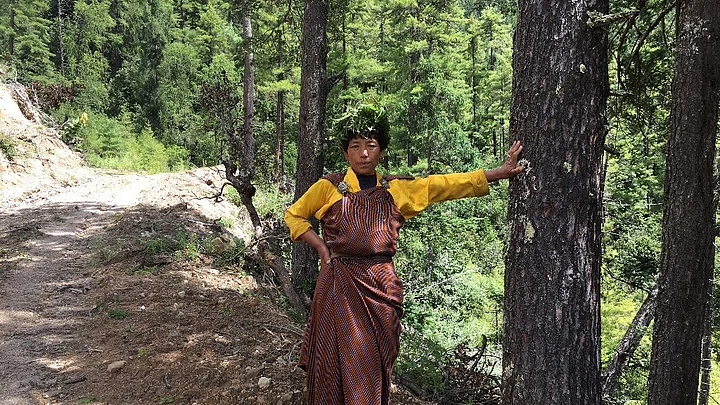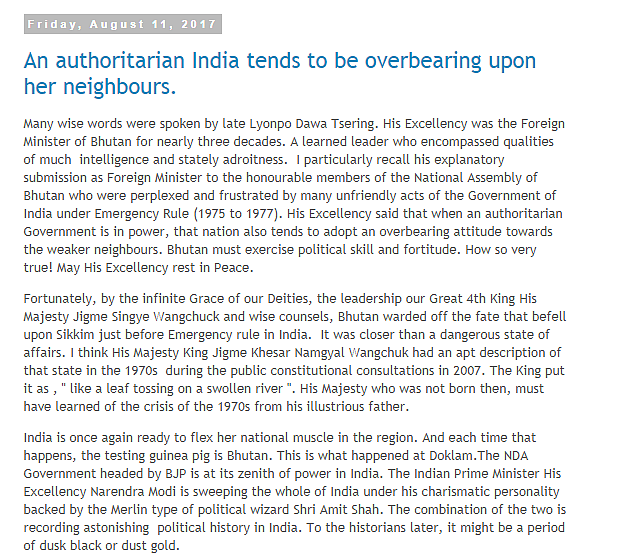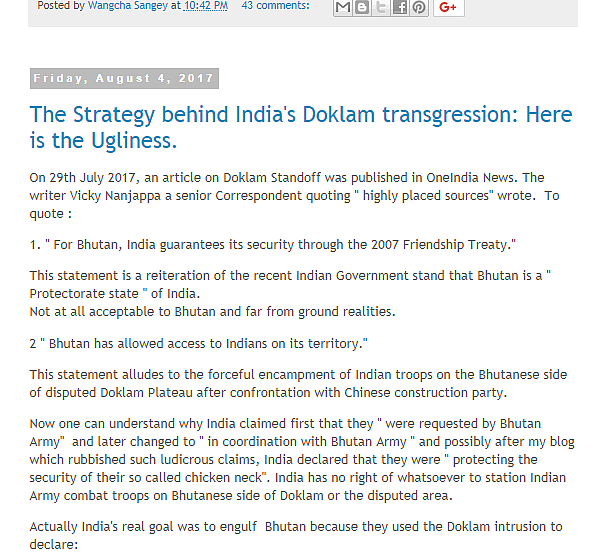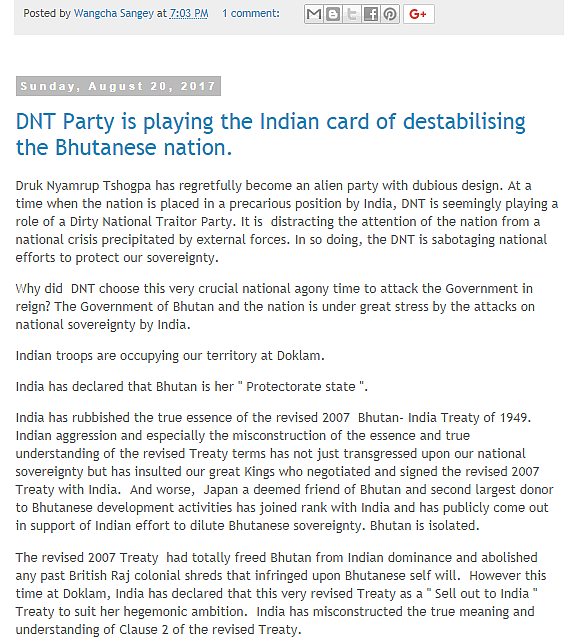Trekking up a steep slope in Damthang, at a crow’s flight distance of 15 kms from Doklam, I had visions of being mauled by a bear. Only a couple of days back, over cups of tea and gulab jamuns, I was told by a senior local journalist in Thimphu that one of his family members was tackled by a bear recently. It is not uncommon to see bears at the outskirts of the capital. And there I was, in the middle of the thickest pine forests, in Haa the “Hidden Valley” trying to get a sense of the geography of the region over which two largest armies in the world locked horns. Leonardo DiCaprio starrer The Revenant came in handy to assess my chances of surviving a bear attack.
This story, however, is not about my human frailties. It is about a land and its people that put themselves on the frontline to honour a friendship despite vulnerability being their national character.
Nationalism and Vulnerability
The silence in Thimphu last week was almost deafening. To my noise-attuned ears, it was nothing short of an abnormality. How does a national capital resist the temptation to discuss one of the most crucial geo-political developments in the region playing out on its land? Forget about the royal family and the political establishment, even the opposition party Druk Phuensum Tshogpa maintained radio silence over the Doklam standoff.
My local source tried to explain that to me.
“When it comes to matters dealing with national security, we Bhutanese are all on the same side.” It corroborated what my Indian source at Indian Military Training Team (IMTRAT) had told me before I boarded the plane to Paro. “Try as you may, nobody is going to talk to you from the establishment: civil or military. The one-liner you are likely to get is ‘Dasho has asked not to speak’”.
Thanks to the guerrilla journalism of some western reporters in the past few weeks, the Bhutanese are sceptical of foreign press. Not because they have something to hide; their scepticism emanates from the acknowledgment of their vulnerability. “Bhutan is like a hare caught in the middle of two roaring lions,” said a teacher in the Haa valley. While the hare may have chosen one lion as its protector, it still remains in jeopardy.
My conversations in Thimphu were all about geopolitics, China being a global bully, Indo-Bhutanese hydropower agreements et al; macro concerns dealing with economic and strategic vulnerabilities. And curiously, on how not to repeat the mistakes that Nepal has made. Sophisticated as a waffle stack topped with honey, maple syrup, banana, and ice cream; with a touch of urbanity that one expects to find in a national capital’s cafes.
As I moved westwards, however, concerns at the micro-level began to emerge in casual conversations with taxi drivers, local shop-owners, farmers and yak-herders. Men and women of soil voicing their earthy emotions. A straight “Nepal people have no manners” from a local driver without getting into the history, culture or politics of the people he just dissed. Tshering Penjor, a farmer from Damthang, takes it as a personal affront that the Bhutanese yak-herders are routinely chased off by the Chinese from the grazing grounds of Doklam and the neighbouring areas.
When the Tibetan yak-herders come to our side we say nothing to them. They (the Chinese) scare us away with their guns!Tshering Penjor, Farmer
Yes, we understand the pain of this inequality.
We Love India, But...
Mr Dorji, my taxi driver from Thimphu, was a voluble man. Although I would have preferred a quiet night-drive after a long day of interviews, it was best not to resist the clichéd cab-talk.
This man was an opinionated talker, who had seen much of India. Not only did he encourage me to have another child – a boy – he made no efforts in hiding his distaste for Bengalis. In his broken English he declared, “People from Madras good, Jaigaon and Siliguri bad.”
While outraged, I had little reason to blame him. Before I left for Haa on Sunday, the streets of Thimphu were flooded with day tourists from the border town of Jaigaon, India. Suddenly, the ambience of the town had altered. From being a quiet, languid town Thimphu got catapulted into a state of chaos. There were paan stains on the streets and raucous laughs and gawky stares lining the footpaths. The kira-clad women of Bhutan and easy and cheap availability of alcohol are big draws, after all.
These are the kind of Indians that the average Bhutanese has to deal with on a daily basis. Mr Dorji, however, had another peeve. “I say very honestly, Indians and Japanese give no tips.” To prove him wrong, I paid a 20% tip at the end of my journey.
Indian Military in Bhutan
Do Bhutanese see the Indian army as an occupying force? This thought was gnawing at my conscience even before I passed the IMTRAT base in Haa in the middle of the night. In the morning, however, I began to get my answers. Recently in the digital media, much has been made of the Indian Army’s occupation of the Haa Dzong, the traditional administrative and religious centre of a Bhutanese district. While a Haa-based blogger named Wangcha Sangey routinely posts virulent attacks on it, the local population is largely at ease with the Indian army.
- 01/03
- 02/03
- 03/03
“Mr Sangey does not represent us. He’s not even a public figure. I don’t know why people in India seem to be even paying any attention to him,” shared M Dorji while serving me breakfast in his cousin’s beautiful farmhouse. Spending two afternoons in the Haa market made me believe him. I could not find even a single Indian army personnel on the street. With a self-sufficient base of their own, the soldiers posted at IMTRAT perhaps find no reason to venture out. The local population does not have to deal with the foreign soldiers, however friendly, on a routine basis. Familiarity may have bred contempt, who knows?
Be it the grocery stores inside the IMTRAT camp or the IMTRAT-run hospital in Haa, the Indian military's long presence in the town to train the Royal Bhutan Army has been a blessing for the local population.
As an Indian passport-holder in rural Bhutan, I did not feel uncomfortable at all. As a journalist, however, I did feel nervous a few times. When the newly-deployed guards just short of the Damthang camp detained me for a search, it felt a bit odd. My driver was equally baffled. As we figured out eventually, some hawkish journalists brought in drone cameras and captured images of restricted areas in the Bhutan army’s China-facing camp. Coupled with factually incorrect and misleading reporting, such gimmicks increased Bhutan’s vulnerability in the past few weeks.
While the people of Bhutan are immensely polite, they do keep their national interest squarely in sight.



